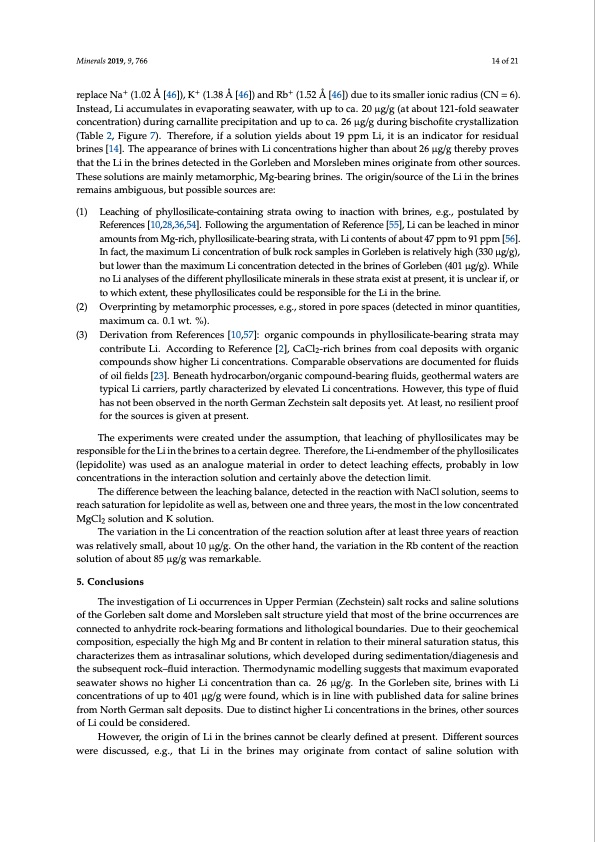
PDF Publication Title:
Text from PDF Page: 014
Minerals 2019, 9, 766 14 of 21 replace Na+ (1.02 Å [46]), K+ (1.38 Å [46]) and Rb+ (1.52 Å [46]) due to its smaller ionic radius (CN = 6). Instead, Li accumulates in evaporating seawater, with up to ca. 20 μg/g (at about 121-fold seawater concentration) during carnallite precipitation and up to ca. 26 μg/g during bischofite crystallization (Table 2, Figure 7). Therefore, if a solution yields about 19 ppm Li, it is an indicator for residual brines [14]. The appearance of brines with Li concentrations higher than about 26 μg/g thereby proves that the Li in the brines detected in the Gorleben and Morsleben mines originate from other sources. These solutions are mainly metamorphic, Mg-bearing brines. The origin/source of the Li in the brines remains ambiguous, but possible sources are: (1) Leaching of phyllosilicate-containing strata owing to inaction with brines, e.g., postulated by References [10,28,36,54]. Following the argumentation of Reference [55], Li can be leached in minor amounts from Mg-rich, phyllosilicate-bearing strata, with Li contents of about 47 ppm to 91 ppm [56]. In fact, the maximum Li concentration of bulk rock samples in Gorleben is relatively high (330 μg/g), but lower than the maximum Li concentration detected in the brines of Gorleben (401 μg/g). While no Li analyses of the different phyllosilicate minerals in these strata exist at present, it is unclear if, or to which extent, these phyllosilicates could be responsible for the Li in the brine. (2) Overprinting by metamorphic processes, e.g., stored in pore spaces (detected in minor quantities, maximum ca. 0.1 wt. %). (3) Derivation from References [10,57]: organic compounds in phyllosilicate-bearing strata may contribute Li. According to Reference [2], CaCl2-rich brines from coal deposits with organic compounds show higher Li concentrations. Comparable observations are documented for fluids of oil fields [23]. Beneath hydrocarbon/organic compound-bearing fluids, geothermal waters are typical Li carriers, partly characterized by elevated Li concentrations. However, this type of fluid has not been observed in the north German Zechstein salt deposits yet. At least, no resilient proof for the sources is given at present. The experiments were created under the assumption, that leaching of phyllosilicates may be responsible for the Li in the brines to a certain degree. Therefore, the Li-endmember of the phyllosilicates (lepidolite) was used as an analogue material in order to detect leaching effects, probably in low concentrations in the interaction solution and certainly above the detection limit. The difference between the leaching balance, detected in the reaction with NaCl solution, seems to reach saturation for lepidolite as well as, between one and three years, the most in the low concentrated MgCl2 solution and K solution. The variation in the Li concentration of the reaction solution after at least three years of reaction was relatively small, about 10 μg/g. On the other hand, the variation in the Rb content of the reaction solution of about 85 μg/g was remarkable. 5. Conclusions The investigation of Li occurrences in Upper Permian (Zechstein) salt rocks and saline solutions of the Gorleben salt dome and Morsleben salt structure yield that most of the brine occurrences are connected to anhydrite rock-bearing formations and lithological boundaries. Due to their geochemical composition, especially the high Mg and Br content in relation to their mineral saturation status, this characterizes them as intrasalinar solutions, which developed during sedimentation/diagenesis and the subsequent rock–fluid interaction. Thermodynamic modelling suggests that maximum evaporated seawater shows no higher Li concentration than ca. 26 μg/g. In the Gorleben site, brines with Li concentrations of up to 401 μg/g were found, which is in line with published data for saline brines from North German salt deposits. Due to distinct higher Li concentrations in the brines, other sources of Li could be considered. However, the origin of Li in the brines cannot be clearly defined at present. Different sources were discussed, e.g., that Li in the brines may originate from contact of saline solution withPDF Image | Lithium Occurrences in Brines from Two German Salt Deposits

PDF Search Title:
Lithium Occurrences in Brines from Two German Salt DepositsOriginal File Name Searched:
minerals-09-00766-v2.pdfDIY PDF Search: Google It | Yahoo | Bing
Product and Development Focus for Infinity Turbine
ORC Waste Heat Turbine and ORC System Build Plans: All turbine plans are $10,000 each. This allows you to build a system and then consider licensing for production after you have completed and tested a unit.Redox Flow Battery Technology: With the advent of the new USA tax credits for producing and selling batteries ($35/kW) we are focussing on a simple flow battery using shipping containers as the modular electrolyte storage units with tax credits up to $140,000 per system. Our main focus is on the salt battery. This battery can be used for both thermal and electrical storage applications. We call it the Cogeneration Battery or Cogen Battery. One project is converting salt (brine) based water conditioners to simultaneously produce power. In addition, there are many opportunities to extract Lithium from brine (salt lakes, groundwater, and producer water).Salt water or brine are huge sources for lithium. Most of the worlds lithium is acquired from a brine source. It's even in seawater in a low concentration. Brine is also a byproduct of huge powerplants, which can now use that as an electrolyte and a huge flow battery (which allows storage at the source).We welcome any business and equipment inquiries, as well as licensing our turbines for manufacturing.| CONTACT TEL: 608-238-6001 Email: greg@infinityturbine.com | RSS | AMP |